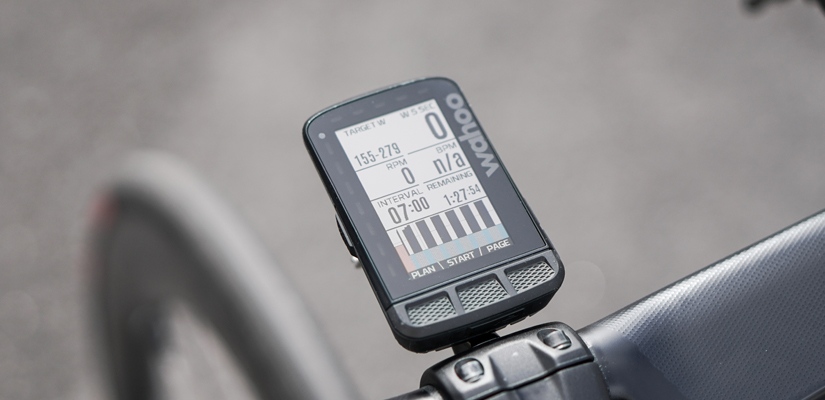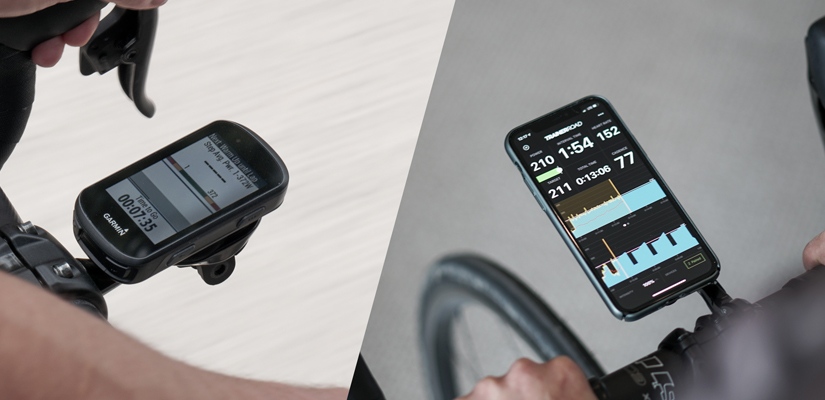Indoor FTP vs. Outdoor FTP: Why They Feel Different (But Aren’t)

Have you ever felt stronger riding outside than on an indoor trainer, or vice-versa? You’re not alone.
One of the most common questions we receive here at TrainerRoad is whether you need to adjust your FTP between indoor and outdoor workouts. The short answer is no, as FTP is rooted in physiology and not affected by external factors. However, this doesn’t mean it’s always equally easy to ride indoors and out. Why does it sometimes feel like your FTP changes in different settings, and what can you do to feel stronger more often?
Key Takeaways:
- FTP is physiologically-based and does not change when riding in different settings or on different bikes
- Ability to actually ride to your potential is affected by external factors
- Experience, Motivation, Hydration, Nutrition, and Equipment can all influence how strong you feel.
- Indoor and Outdoor abilities usually equalize if you practice both regularly.
What is FTP?
FTP is short for Functional Threshold Power. Physiologically, it is the point at which the balance of aerobic and anaerobic energy systems is overwhelmed. As exercise intensity rises, the body’s ability to aerobically sustain and fuel muscular activity reaches its maximum. More demand is placed on the anaerobic system, with lactate produced as a byproduct. Eventually the muscles’ ability to clear this lactate is overwhelmed and it begins accumulating in the blood. This tipping point is known as the lactate threshold and represents the intensity at which long efforts become unsustainable.
In practice, FTP often refers to the maximum cycling intensity you can sustain for an hour. Measured in watts and estimated by a Ramp Test, FTP serves as the benchmark for fitness in TrainerRoad. From your FTP, we calculate your Training Zones and set the intensity of the workouts in your training plan.
Same FTP, Different Circumstances
By definition, FTP is a function of metabolic and muscular capabilities. It changes over time as you become more or less fit, but it is not affected by short-term external factors from outside the body. Still, most riders know that actually sustaining FTP for an hour is extremely difficult. It’s painful, exhausting, and mentally challenging. Add in factors such as heat or fatigue, and efforts at threshold are even harder. These are all illustrations of another important fact- your physiological fitness is different from your ability to actually express that fitness in the real world.
Herein lies the misunderstanding about indoor and outdoor FTP. You are just as fit a rider indoors as out, whatever bike you are riding, whatever the weather, and whatever you’ve eaten. It’s your ability to ride to your potential that changes, influenced by limiting factors. This should be good news – fitness improves slowly and takes hard work, but outside influences are usually easy to fix.
Adaptive Training
Get the right workout, every time with training that adapts to you.
Check Out TrainerRoadCommon Limitations and Suggestions to Fix Them
Let’s examine the most common reasons it might feel like FTP is lower indoors or outside, and figure out how to remedy these limitations.
Experience
Riding the trainer is hard. You’re locked in position, with less ability to shift your weight and take breaks than outside. No matter how expensive your trainer, riding inside feels different than riding outdoors, with resistance distributed more uniformly across the pedal stroke and lacking the variations afforded by real-world terrain. However, these challenges all tend to disappear over time. While your first few indoor rides may feel disproportionately hard, most cyclists find the gap between their indoor and outdoor abilities narrows with practice, and seasoned TrainerRoad athletes usually report identical capabilities indoors.
This proves the value of experience- more practice riding the trainer is the easiest way to feel stronger and more comfortable inside. If you’re new to riding indoors or don’t ride the trainer often, cut yourself some slack. Don’t be afraid to backpedal or take occasional mid-ride breaks, and after a few rides you’ll almost definitely start feeling better.
Key takeaway: The more often you ride the trainer, the more comfortable you will feel riding indoors.
Motivation
Riding outside is exciting, with scenery, friends, and Strava segments all serving as incentives to go harder. Indoors, many riders find it tough to find the same motivation. The easiest remedy to this is an effective training plan, which assigns purpose to each ride and eliminates wasted time. TrainerRoad plans are designed as efficiently as possible, with most of our workouts manageably short and packed with productive efforts.
The other important way to increase motivation is to make your training experience more stimulating. Good music can help, or you might stream a movie or watch a bike race as you ride. Finally, TrainerRoad Group Workouts can serve as incredible motivation, bringing the shared camaraderie of group rides to the indoor trainer. Group Workouts support up to 11 riders and can even be used for Ramp Tests.
Key Takeaway: Purposeful training, on-bike entertainment, and Group Workouts can help motivate you to ride harder indoors.
Cooling
Far and away, the biggest physical limitation to indoor cycling performance is cooling. Outside, you’re in constant motion, with sweat rapidly dissipated by airflow over your body. It’s easy to underestimate how dramatically this affects you. ¾ of the energy consumed by the muscles is converted to heat, and the more intense the effort the more heat is generated. Retention of this heat causes a rapid and dramatic decrease in work capacity.
Many riders mistakenly use just a small fan blowing at their face to cool down, but your torso and legs are most in need of heat reduction. Ideally, we recommend powerful fans such as the Lasko Performance Series (a personal favorite of the TR podcast hosts). Depending on the ambient temperature and humidity in your training room, multiple fans can be a good idea, as can turning up the air conditioning. Riding shirtless or in a base layer with a second fan angled at your back can be an effective tactic to stay cool.
Conversely, if you live in a very hot climate, cooling may be a reason you feel stronger indoors. Many riders find their abilities reduced during training and events in hot temperatures. If you are planning to ride or race in extremely hot weather, it can be of value to intentionally limit your cooling indoors to trigger heat adaptation. Use caution and check out our advice for this here.
Key Takeaway: Cooling is the most important factor in indoor rides and you probably need a bigger fan than you think.
Hydration and Nutrition
Closely tied to cooling, hydration is often overlooked when riding indoors. Studies show that performance declines begin at just 2% dehydration, with a measurable reduction in cardiac output. This further reduces the body’s ability to regulate heat, compounding the effect. In addition, even slight dehydration decreases the rate of gastric emptying, effectively eliminating your ability to process any fuel you take in. For long workouts, this can be a major limiting factor. Dehydration can be a threat on any ride, but since evaporative cooling is less effective inside, the body sweats more on the trainer and it can happen more quickly. Click here for helpful hints on indoor hydration.
Good fueling is also essential inside. Most riders know to eat during intense rides outdoors, but it’s far less common to eat while riding the trainer. Nutritional needs are the same indoors and the longer and more intense the workout, the more important it is to take in carbohydrates.
Key Takeaway: Dehydration occurs more quickly indoors than outside, and eating and drinking are crucial on the trainer.
Equipment
Finally, consider your equipment as a possible cause. Discrepancies between power meters are common, especially if you are using different models when indoors vs. outside. PowerMatch can help remedy this, allowing your bike’s power meter to control a smart trainer instead of using the trainer’s internal meter. Calibrating your power meter consistently before each ride can also help.
Position on the bike can also be a major factor. Some trainers don’t hold bikes level and require the use of a front wheel riser, otherwise resulting in an artificially aggressive and uncomfortable position. If you are using a different bike on the trainer than you are using outside, make sure fit parameters such as saddle angle, drop, and reach are as consistent as possible. An exception to this rule is if your goal event requires you to be in an aero position or use a unique bike, and that event is your singular focus. In this circumstance we actually recommend testing your FTP in aero position and training on the bike you’ll be racing. This FTP estimate might be lower than your actual physiological capability, but training specificity is most important in this scenario.
One other difference between riding the trainer and riding outside is inertia, and how the momentum of your rear wheel changes the dynamics of the pedal stroke. It’s a complicated topic, but gear selection and trainer type can influence your ability to generate power indoors. Broadly speaking, riding the trainer in the small ring is more analogous to the steady resistance of a climb, while riding in the big ring better replicates the experience of riding flat roads at speed. Choosing your indoor gearing based on what terrain you ride most can help to make your indoor experience more consistent and effective.
Key Takeaway: Differences in power meters, riding position, and gear choice can dramatically change your experience when riding indoors.
Further reading:
The Beginner’s Guide to Indoor Cycling
Functional Threshold Power (FTP): What it Means to Cyclists
Is My FTP Representative of My Maximal “Hour Power”?
How to Use Carbs for Maximum Performance
For more cycling training knowledge, listen to the Ask a Cycling Coach Podcast— the only podcast dedicated to making you a faster cyclist. New episodes are released weekly.

